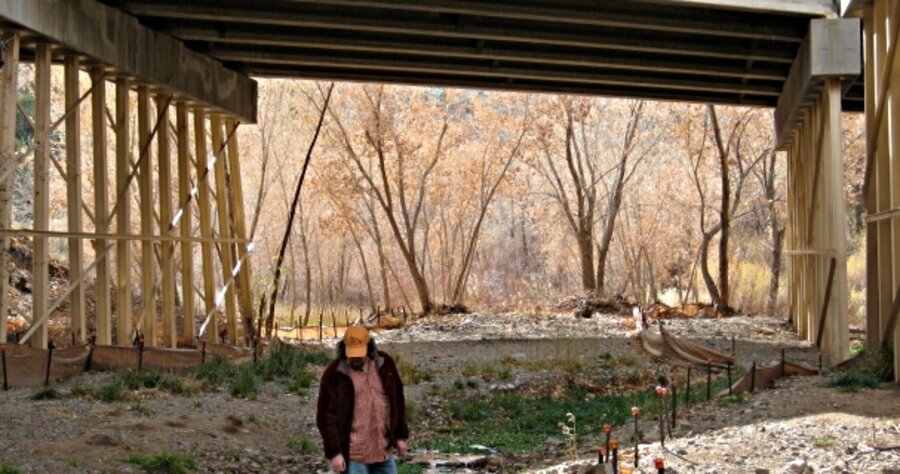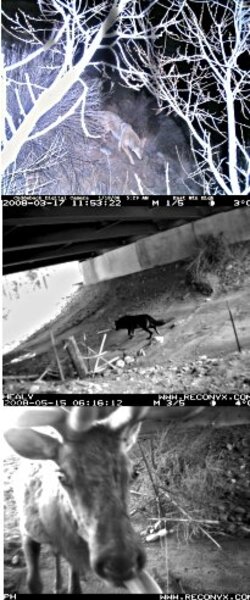In New Mexico canyon, a novel way to prevent roadkill
Loading...
| Albuquerque, NM
In 2003, a group of New Mexico students began lobbying the state legislature to address collisions between vehicles and wildlife. The Wild Friends program at the University of New Mexico’s Law School in Albuquerque works with classrooms in Grades 4 through 12 to draft legislation on issues students find important. That year, they decided to tackle vehicle-wildlife collisions, a growing problem nationwide.
“It’s an issue that just about every student in the program has experience with,” says Carolyn Byers, director of Wild Friends. In New Mexico classrooms, stories abound of such encounters, she says.
The Legislature pledged to address the problem. Subsequent analysis of collision data revealed “hot spots” – areas critical to both people and wildlife where a little mitigation could go a long way. Tijeras Canyon, just east of Albuquerque, was one such place. There, on its journey from California to North Carolina, Interstate 40 passes between the Sandia Mountains to the north and the Manzanitas to the south. The canyon, which also contains a creek – a magnet for thirsty animals – is a critical crossing point for wildlife moving between the two wilderness areas.
Now, as a result of the process originally kicked off by students – and subsequent work by citizens’ groups – state agencies have installed fences to guide mule deer, black bears, cougars, and other wildlife through safe passages beneath I-40. So far, the project – completed last year for the relatively modest sum of $750,000 – seems to be working. Before, collisions on I-40 in Tijeras Canyon averaged between 20 and 30 yearly. This year, there have been only three.
The wildlife passage, the first in New Mexico, also tries to address scientists’ broader concern over increasingly fragmented landscapes. To remain healthy, wildlife populations need to maintain gene flow among populations, scientists say. A small isolated population can lead to inbreeding, and limited genetic variation can hinder a population’s ability to adapt to environmental changes over time.
Unfortunately, natural habitat is increasingly fragmented by cities and farms, not to mention crisscrossed by highways. By one estimate, roads alone affect the ecology of 15 to 20 percent of all US land. Safe passages for wildlife – over or under roadways, as well as corridors connecting separate patches of wilderness – may help ease this. They permit wildlife to graze, hunt, and interact over larger areas.
Climate change is another concern. As the climate warms, scientists expect habitats to move toward the poles and, on mountains, upward.
Wildlife suited to these ecological niches will shift as well. Scientists have already observed what they say are climate-induced migrations of plants and animals. With climate putting wildlife on the move, barriers like I-40 could theoretically supply a critical blow to a population or species.
“If you don’t allow for passage of wildlife over large areas,” says Kim Vacariu in Portal, Ariz., “you’re going to exacerbate the extinction crisis that we face right now.” He is the western director for the Wildlands Project, a conservation organization.
The present economic turmoil notwithstanding, the movement to create or preserve connections among wild areas has gained momentum in recent years, especially in the relatively sparsely populated West.
In June, the Western Governors’ Association voted to make wildlife corridors a top priority. Wildlife overpasses – bridges over highways planted with trees and grass to make them more attractive to wildlife – already arch over roads in Canada and Florida. Colorado, Washington State, and Arizona are planning them. Organizations such as the Wildlands Project, meanwhile, are pushing for a north-south wildlife corridor along the “spine of the continent”: a 5,000-mile swath of unbroken wilderness from Mexico to Alaska along the Rockies.
But while these plans – halfway between dream and reality, according to Mr. Vacariu – may sound grand, efforts to establish wildlife migration routes inevitably begin as a safety issue for humans.
In the United States, there are between 725,000 and 1.5 million vehicle collisions with ungulates (hoofed animals that include deer, elk, and moose) yearly. Collisions with deer alone cost $1.1 billion in vehicle damage annually. And they’re on the rise.
A recent report by the Highway Loss Data Institute, an auto insurance-funded research organization, found that claims resulting from wildlife-vehicle collisions have increased 15 percent in the past five years. Fatal crashes have gone up by half since 2000. The study points to increasing human encroachment on wildlife habitat as one cause. The good news: Wildlife crossings can help. A study in Canada’s Banff National Park in Alberta found that, with 24 wildlife underpasses and overpasses in place, collisions fell 80 percent.
“This whole thing is really about safe passage,” says Vacariu. “Humans need that, and so does wildlife.”
New Mexico reports some 800 collisions yearly, likely half of the actual number, says Mark Watson, a habitat specialist with the state’s Department of Game and Fish in Santa Fe. Trucks pulling semitrailers, usually undamaged during collisions, often don’t report them, he says.
Low on funds, state officials were happy to discover that I-40 had three already-existing underpasses in Tijeras Canyon, says Jeff Fredine, an environmental analyst at the NMDOT in Santa Fe. Two additional culverts could also provide passage for top-of-the-food-chain critters like bears and cougars – animals without fear of dark, cramped quarters.
NMDOT installed fencing, some of it electrified, to funnel wildlife toward the underpasses. It also created an overland crossing on a frontage road that runs parallel to I-40 in the canyon. There, electrified mats keep animals moving forward. Lights, triggered by motion sensors, warn motorists of crossing critters. DOT also cleared brush from the underpasses to make them friendlier to predator-wary deer, which are the No. 1 concern.
“We just needed to clean out the underpasses and give [the animals] an incentive,” says Mr. Fredine.
Now, Mr. Watson finds coyote, mule deer, and bobcat prints in the muddy passages.
The project went remarkably smoothly and quickly, says Kurt Menke, co-chair of the Tijeras Canyon Safe Passage Coalition in Albuquerque, a citizens’ group that helped in the effort. One reason: It was framed as a safety issue.
“It’s kind of a win-win,” says Menke. “No one wants to hit a deer.”
The fencing may be having some unintended consequences: Finding their habitual crossing areas blocked by fences, and not yet familiar with the underpasses, animals are loitering more in the Village of Tijeras (population 500), says village mayor Gloria Chavez.
“The animals are getting stuck,” Mayor Chavez says. Her daughter hit a deer last May and, in September, a prowling bear sent the local elementary school into lockdown.
It may take a generation for some animals to learn the new routes, Watson says. There are other kinks, too: Bears were involved in two of the three collisions this year, for example. They may pose a unique challenge to designers of highway wildlife crossings. The Banff study found that, although grizzlies use overpasses, installing safe road crossings had no impact on the number of vehicle-bear collisions: Accidents rose in concert with the amount of traffic on the road.
These large, headstrong animals may simply not be deterred by electric fences, Fredine says. “They are big animals,” he says. If they’re determined to cross, there may be no way to stop them.






